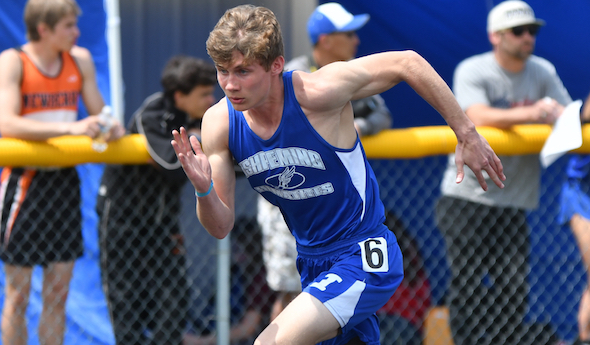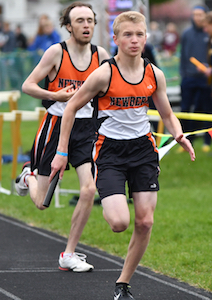
Ishpeming Boys Go Distance Again
By
John Vrancic
Special for MHSAA.com
June 2, 2019
KINGSFORD – The Ishpeming boys continued their winning ways at Saturday's Upper Peninsula Track & Field Finals, retaining their Division 2 crown with 129 points.
This marked the fifth title in six years for the Hematites, who were followed by Newberry at 84 and Norway with 75 points.
Ishpeming, led by junior Jonah Broberg, scored 56 points in the distances.
Broberg won the 800-meter run in two minutes, 6.57 seconds and 1,600 (4:45.81), helped the winning 3,200 relay (8:44.13) and placed second in the 3,200 run (10:38.7). Senior Spencer Giroux was third in the 800 (2:09.43) and 1,600 (4:47.42).
Senior Coulton Prillwitz added firsts in the 300 hurdles in 44.25 and long jump at 19 feet. Classmate Gavin Sundberg took the 400 (52.22) and was runner-up in the 200 (23.73).
Manistique’s Alex Misniakiewicz earned his first title in the 3,200 (10:35.23) as D-1 and D-2 athletes ran together.
"I felt real good," said Misniakiewicz, who placed second in the 800 (2:07.4) and 1,600 (4:47.36). "I paced off Adam Bruce (D-1 champ) for 2-3 laps, and if it weren't for Jonah Broberg, I would have never been able to do this. With a couple laps to go somebody from the stands yelled out, 'You have to go. That's how champions are made!' I know that wasn't meant for me, but I just picked it up. In the last 200, I felt I had a pretty good chance to win it."
 Newberry got its lone first in the 1,600 relay (3:45.25) and was runner-up in the 3,200 relay (8:50.49).
Newberry got its lone first in the 1,600 relay (3:45.25) and was runner-up in the 3,200 relay (8:50.49).
"We're pleased with our time," said senior Evan Griffis, who ran the second leg in the 3,200 relay. "We were close to Ishpeming for half of the race. Our fourth leg (sophomore Ephram Evans) ran exceptionally well and caught them, but he couldn't quite finish them off. We ran one of our better times, and this is the place to do it."
Norway senior Mitch Legrave captured the 100 (11.5) and 200 (23.56) and helped the Knights take the 400 relay (46.25).
St. Ignace junior Joe Kelly won shot put (46-2½) and was runner-up in discus (117-10).
"Our boys are coming along nicely," said Saints' coach Trudy Olsen. "They work hard. It's nice to see them have some success. Joe had already set the school record in shot (49-9) in our season opener. He missed by just a half inch last year. He was motivated."
Hancock sophomore Austin Salani, who was crowned Western Peninsula Athletic Conference pole vault champion with a school-record leap of 13 feet on May 22 in Houghton, took the U.P. title at 12 feet this time.
PHOTOS: (Top) Ishpeming’s Gavin Sundberg takes off during the 400 on Saturday. (Middle) Newberry’s Evan Griffis begins his leg of the 3,200 relay. (Photos by Cara Kamps.)

Track Gaining Speed Toward Future with Electronic Starting Devices
By
Steve Vedder
Special for MHSAA.com
May 23, 2023
Aubrey Greenfield thinks it might be the perfect time to reevaluate 130 years of tradition.
For a number of reasons, from technical to personal, the Oxford senior sprinter believes it makes sense for the crack of a starting pistol to be eliminated from high school track meets.
Because track meets would benefit in various ways from lowering costs to easier setup at meets to the human factor of competitors not having to flinch at the crack of a pistol shot, Greenfield believes the sport has a chance to embrace new technology – electronic starting devices (ESD).
In essence, an ESD replaces the starting pistol with a light flash, tone sound or both to begin a race.
"High school sports should put the athlete first," Greenfield said. "We should promote sports, and eliminating starting pistols promotes health in terms of PTSD or trauma for athletes and spectators and that would be good. I would like to think people would say that's a good idea."
In fact, Greenfield would go as far as to say if there was not an implementation of electronic starting devices, many of her teammates would have considered giving up the sport.
"If it's something that helps us compete safely, we're all for it," she said.
Greenfield's opinion apparently is spreading. Michigan High School Athletic Association senior assistant director Cody Inglis said the use of ESD makes it both affordable for meet starters and sensible for athletes and fans to rethink the use of starting pistols. While the MHSAA is not mandating electronic starting devices, it does promote the use of what Inglis calls "emerging technology." He notes that ESD are becoming the norm for organizations such as USA Track & Field, the NCAA and an increasing number of high schools.
 "I think we have to embrace new technology, and we think this will be something that takes hold," Inglis said.
"I think we have to embrace new technology, and we think this will be something that takes hold," Inglis said.
A key part of embracing ESD is the human element. The tragic Oxford High School shooting Nov. 30, 2021, that took the lives of four students while injuring seven others should not be relived even for a fleeting instance at a high school sporting event. Oxford athletic director Tony DeMare said the school began using ESD at every meet, including the MHSAA Lower Peninsula Division 1 Finals last June. He said that decision was embraced by virtually all schools Oxford encountered.
"We were very convinced that the alternative (of ESD) would promote a healthy attitude," DeMare said. "We were overwhelmed with the positive response. If a school was on the fence about it or might not be for it, I think we've started to see the tide turn in favor of people willing to listen and learn about electronic starting devices."
Inglis said the MHSAA is acutely aware of what the crack of a starting pistol can mean to athletes and fans.
"It's unimaginable what Oxford went through, and this is a small way we can help," he said. "We look at a (starting pistol) and think, ‘Could we do something else?’ It's a way of helping to solve a problem."
Over the last several years, the MHSAA has embraced finding an alternative to starting pistols. Inglis noted the discussion started with the cost and diminishing availability of 32-caliber ammunition that meet starters use. A box of ammunition, if it can be found, is around $75 a box.
In addition to cost, there is potential damage from excessive exposure to 150-plus decibels of sound generated by the traditional 32-caliber blanks. Medical studies show damage to ears caused by decibel levels above 120 dB.
The tragedy at Oxford accelerated the conversation.
Inglis said the cost of ESD can be likened to a school sinking money into artificial surfaces at football fields. Yes, there is a great cost at first, but over time money is ultimately saved. An ESD system itself ranges between $200 and $500. Speakers also may need to be purchased, but with ESD starting events like the 800 and 1,600-meter relays positioned near the outside lanes 8, 7, 6 and 5 would result in improved hearing by athletes at the start of a race.
There is one challenge with ESD that track administrators are working to overcome – lighting conditions that lessen the ability to see the ESD’s LED light or strobe when the button is pressed by a starter to begin a race. But that vision difficulty resulting from clear blue skies and backgrounds of setting suns can be substantially improved by incorporating a black background with an ESD – something as simple as a starter holding up black cardboard behind the lighting mechanism at the start of an event.
Inglis said when all factors are considered, the use of ESD makes sense.
 "With the climate we live in nowadays, no lookalike guns is good," he said. "We're not mandating this. But people are saying this is affordable."
"With the climate we live in nowadays, no lookalike guns is good," he said. "We're not mandating this. But people are saying this is affordable."
While switching to ESD would break 130 years of tradition, the timing could be a step forward, said Jeff Hollobaugh, co-author of the book "The Fleet Feet of Spring: Michigan's High School State Championships in Track & Field." He said while no definitive answer is possible, it's likely starting pistols were used at the inaugural state meet at the Jackson Fairgounds in 1895. The meet, which included events like tossing a 16-pound shot put, bike races and a 100-meter sprint, was sponsored by the Michigan Interscholastic Athletic Association (a predecessor to the MHSAA) and comprised mostly of the state's larger schools.
Hollobaugh's sentiments echo what many involved in today's high school track & field believe in terms of making a transition from starting pistols to electronic starting devices.
"It's a change, not necessarily good or bad, just different," he said. "It's not a drastic change, but it will take some getting used to. But it is the future. In the end, we'll all be fine."
DeMare believes the future of high school track will definitely include ESD.
"Our desire is that the practicality and sensibility of this will overcome the alternative," he said. "I think we'll see the automation and electronics taking hold of certain elements in track, and people will embrace it."
PHOTOS (Top) Runners watch official Bertha Smiley as they prepare to begin a race during last season's Lower Peninsula Division 1 Finals at Rockford. (Middle) An electronic starting device provided by VS Athletics was used to start those races. (Below) Smiley sets to begin an event. (Photos provided by David Kuderka/VS Athletics.)

